Amb. Khamsouay Keodalavong of the Lao People’s Democratic Republic in Seoul
“The socio-economic cooperation between the Lao People’s Democratic Republic and the Republic of Korea is steadily expanding and developing, and now Korean investments in Laos rank number four with the bilateral trade increasing year by year as well as the development in the field of people-to-people exchange and tourism,” said Ambassador Khamsouay Keodalavong of the Lao People’s Republic in Seoul in a recent article specially contributed to The Korea Post media for publication on the occasion of the Laotian New Year, 2560. The following are details of the article of Ambassador Keodalavong.—Ed.

On behalf of the Embassy of the Lao People’s Democratic Republic to the Republic of Korea I would like to thank you and highly appreciate to The Korea Post for allowing our Embassy to publish this article regarding the Lao New Year.
According to the lunar calendar this year 2560 (2017) the Lao New Year falls on 13t-15th of April, and during these festive holidays, traditionally Lao family members reunite and celebrate together at home. Everybody old, young, men, women and children are happily playing water, doing other activities according to Lao tradition and culture.
Water is for washing Buddha’s images, monks, and soaking friends, passers-by and homes. Young people first respectfully pour water on their elders, monks for blessings of long life, good health and prosperity and last of all they throw water on each other. The water is perfumed with flowers or natural perfume, and most of the people prefer flowers in the water to give a pleasant smell as well as adding cologne or perfume.
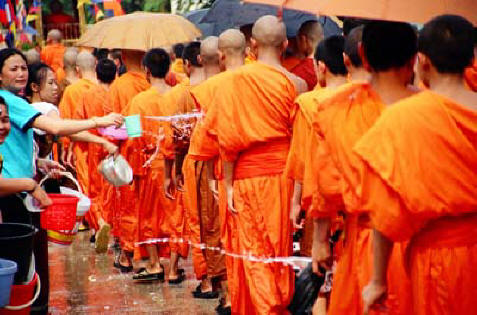
During these 3 days celebration of the New Year how do the Lao people celebrate?
First day 13th of April is the last day of the passing year. Perfumed water and flowers are prepared for the New Year. In the morning, in the temples or pagodas all over the country the Buddha images are taken down by monks from their permanent places and place on special temporary easy-to-access places within the temples compound, so people or villagers can pour perfumed water on them. They also pour the water to each other wishing a Happy New Year. This is believed to bless, clean and purify the receivers before entering into the New Year.
On the second day 14 April is the "day of no day", a day that falls in neither the old year nor the New Year. Usually in this day after coming back from temples, people stay at home doing house works, houses are properly cleaned in the second day. Traditionally people will not be allowed to take nap or stay still on the second day as it’s believed that if one sleeps or stays still one will get sick in the coming year. They encourage the young people to clean their places and go out to continue to pour water on other relative elders in the village and wish them well and finally get wet themselves. This is a way to clean and send bad things away with the old year.
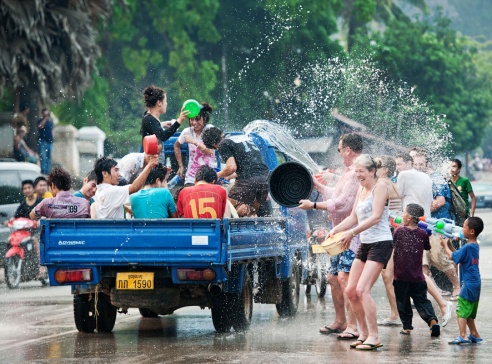
The last day of the festival marks the start of the New Year. People continue playing water, some stay at home preparing for the family common activities, because this day many families will hold a Baci ceremony at their house to welcome the New Year as well as to wish their elders as well as all members of the family a good health and long life. Most of the people might respectfully ask for forgiveness from their elders for things that they did in the past year that might have hurt their feelings unintentionally. And at the same time they give the elders gifts.
In late afternoon of the last day, in the temples the Buddha images are moved back to their permanent places. In the evening devotees go to temple to listen to the monks chanting as an act to ask for forgiveness from the monks as well as from the Buddha images for what they did (pouring water on them) in this past few days that might have accidentally touched them ( monks and Buddha images are not to be touched especially women ). After that, in the evening, in the temple a vien tien – or a candlelight procession – takes place around the temples and that is the end of the Lao New Year celebration.
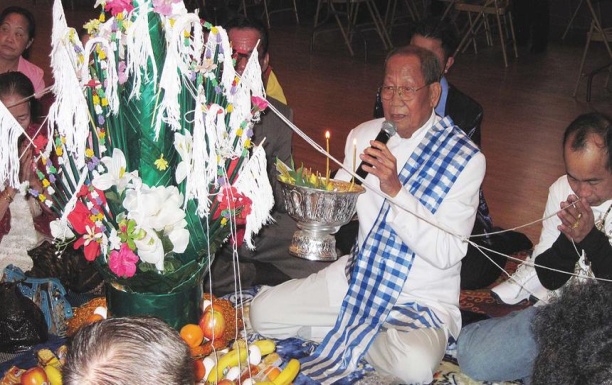
Lao New Year celebration in different part of the country Lao multi-ethnics people would have their own traditions especially in Luang Phrabang. There will be a little bit different from others where there are the most authentic and typical traditional activities during the New Year time and maybe it would last for some more days longer maybe for a week. There are also some more activities during new year such as Lao new year - parade which led by red-faced mythical characters called - Pou Gneu and Gna Gneu mask dance (Grandpa and Grandma Gneu). Annual beauty pageant contest in Luang Prabang called the Nang sangkhane or the beauty of songkane. Going to Buddha cave or Thamting and so on
The Baci ceremony is Lao customs of blessing.
Baci (also spelt basi) is specific ceremony in Laos which has been practiced for hundreds of years. The term commonly used is “sou khuan” which means “spirit enhancing or spirit calling”. The ceremony involves the tying of white cotton strings around person’s wrists and the prayer saying or well wishing for the person that the ceremony is intended for.

Lao people believe that a human being is a union of thirty-two organs, each organ has a spirit or khuan to protect them. These spirits often wander outside the body causing imbalance of the soul which might lead to an illness. The tying of the strings represents tying of the 32 spirits to the body putting them back in harmony as well as bringing good luck and prosperity to the intended person, could also be common for a hole family.
The baci ceremony is held on many different occasions or events throughout the year. The ceremony can be held for both on the sad or happy occasions like new year, wedding, welcoming guest, house warming, new born baby, traveling for long period of time, after recovering from illness and so on. The Baci is starting with everybody is seating around the Pha khouane which is well decorated with flowers, candles, fruits, boiled eggs, chicken or pork, drinks, sticky rice. Mor phone or chanter is chanting and wishing some time in Bali-sansacrit and Lao languages. The context is about wishing a good luck, good health, happiness and call back the spirits.
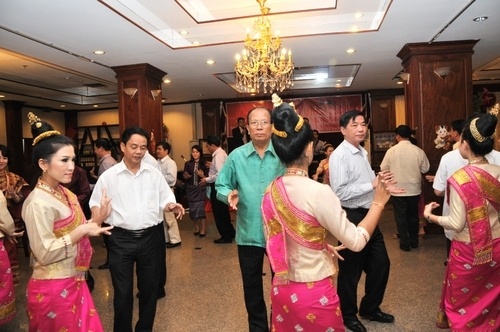
The baci procession finishes when everyone has tied the white or color strings around everyone else’s wrists or when the strings have run out. The ceremony varies in length from 30 minutes or more. And then usually, after the strings tying procession has finished everyone is invited to have meals (Lunch or Dinner) together, drinks and continued by entertainment lam wong (Lao circle dance) or singing songs with a live band playing.
Last year 2016, the Lao PDR had successfully completed the Chairmanship of ASEAN, we have hosted several meetings during the ASEAN summit such as ASEAN Foreign ministers Meeting, ASEAN summit 28th and 29th, several ASEAN and dialogue partners summits such as ASEAN plus three, ASEAN-China, ASEAN-Japan, ASEAN-Korea, the 11th East Asia summit and some other meetings in our Vientiane capital. For this, the Lao Government and people highly appreciate all the participating friendly countries for assistance and contribution during the Laos’s ASEAN chairmanship.
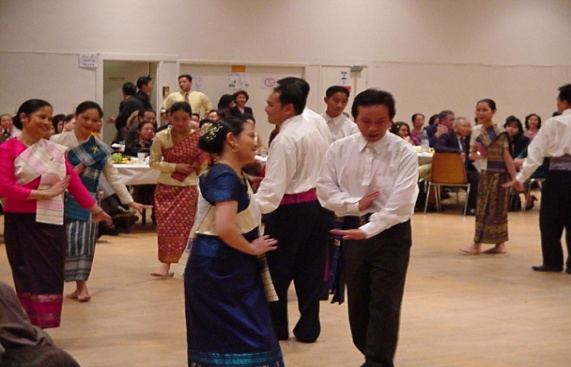
Besides those regional meetings, the Lao Government and people also had the opportunity to receive the historical visit of many heads of states and governments to officially visit Lao PDR including Barack Obama of United States, Chinese Prime Minister Li Keqiang, Prime Minister Shinzo Abe of Japan, Rodrigo Duterte of the Republic of the Philippines, President Park Geun-Hye of the Republic of Korea and some others. It was a successful and fruitful bilateral visit of the Korean President to the Lao PDR. We have signed several memoranda of understanding between our two countries, covering co-operation and assistance in the fields of politics, economy, culture, education, trade, investment, tourism, people to people as well as rural development.
Social-economic cooperation between the Lao PDR and the Republic of Korea is steadily expanded and developed, and now Korean investment in Laos is ranking number four, our bilateral trade also year by year increases as well as the development in the field of people to people exchange and tourism.

